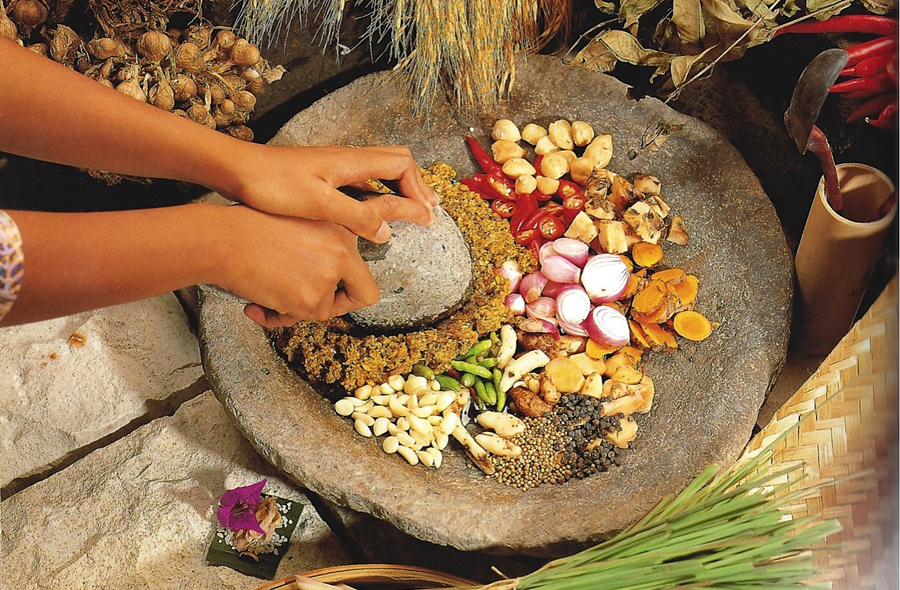
Customs and Cuisine of Indonesia
Bali’s landscape is characterized by abundance: thousands of lush rice fields, coconut palms, tropical fruit trees and coffee plantations; the seas surrounding Bali are rich in fish; and the soil is made fertile by occasional volcanic eruptions of ash and debris.
A significant aspect of dining rituals in Bali consists of offerings made to appease the gods and deities that the Balinese worship on a daily basis. They have remained staunchly devoted to the Hindu religion. Therefore, meals are either “regular daily food,” based on rice with a range of spicy side dishes, vegetables and small amounts of meat or fish, or “festival food,” intended for the gods. Although their spiritual beliefs prevent them from eating beef they do consume pork—it is a very popular festival food—as well as chicken, duck, and fish.
Daily meals are eaten twice a day, with the preparation for both typically done in the morning and left in the kitchen for the family to help themselves to whenever they’re hungry. These meals are not sociable affairs, often eaten quickly and alone. Snacking at street carts and markets is encouraged to stave off hunger until regular mealtime.
In contrast, food for festive occasions is labor-intensive, exquisitely decorated and eaten communally. The people of the village will gather together to help prepare, slice and chop ingredients for their own feast, as well as to elaborately decorate platters of food for the gods. Once the offerings have been made, and the “essence” has been consumed by the gods, the edible portions are enjoyed by the families who brought them.
Rice is the staple food of the Balinese, and the word for cooked rice (nasi) is synonymous with the word for meal. A big plate of steamed white rice is the usual way it is presented, and often at room temperature.
Dewi Sri, the Rice Goddess, is undoubtedly the most worshipped deity in Bali. Her likeness is represented all over the island; as an hourglass figure often made from rice stalks, engraved or painted onto wood, or even made out of cooked rice!
Although bland white rice is a staple food, the Balinese do their very best to jazz things up. Besides white rice, coconut works its way into almost every dish. Food is flavored from a vast array of the many spices, wild herbs and fragrant roots that grow on the island. These ingredients are turned into spice pastes, called bumbu-bumbu, that are typically pounded in a mortar and can take up to 30 minutes to pulverize! Thankfully we have food processors that can reduce this task to minutes.
Dining Etiquette:
- Eating with your right hand is traditional, although spoons and forks are popular with the younger generation. The fork is held in the left hand to move food onto the spoon.
- Hands must be washed before and after eating. The left hand is never used to eat or pass food.
- Do not begin to eat or drink until the oldest man at the table has been served and has begun.
- The most honored position is in the middle of the table, with the second most important person seated next.
Source material: The Food of Bali, Periplus Edition
View Recipes from Indonesia
Indonesia
